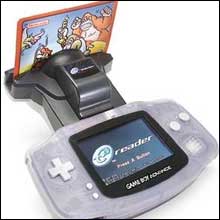The Nintendo e-reader isn’t what you think it is; it isn’t a device for reading e-books. The truth is, I’ve just lured you here to read an article about an obscure peripheral for the Game Boy Advance by implying that Nintendo made a Kindle-style e-reader. E-readers are hot right now, aren’t they? It’s all Kindle-this and iBooks-that. I bet a Nintendo one would be lovely, all white and curvy like that Wii U tablet controller.
No, the actual Nintendo e-reader was an official product from Nintendo, a device that plugged into your GBA and allowed you to swipe cards with barcodes on and load various games. The device was a bulky thing, almost as big as the GBA itself and bigger entirely than the Game Boy Advance SP model that came later. Using it was about as exciting as that sounds; someone at Nintendo obviously saw how much fun it was to swipe your own items at the supermarket checkout and thought “We need to get in on that action”. Presumably the same department that came up with, say, the Wii Vitality Sensor rather than the excellent GameCube bongos. I don’t think the e-reader was ever officially released in Europe but then I’m someone who ended up getting a Japanese SwanCrystal so regional difficulties don’t seem to bother me.

Anyway, these cards. They came in foil packets containing up to five cards per game, so immediately they triggered my forgiving nostalgia gland because it was a bit like buying Panini stickers from the newsagent, back when ‘panini’ was a sticker manufacturer and not an Italian bread product. On the downside, they didn’t come with a stick of low-quality chewing gum, nor was there the frisson of excitement that came from not knowing what was in the packet. At no point was anybody buying these things going to end up with another Pokémon Battle-e card instead of the highly-coveted Mario VS. Donkey Kong.
The scanning process was slow, tedious and prone to error, taking all of the worst aspects of the self-checkout process and dropping all of the best. A typical NES game came on five cards, each of which had to be swiped twice, and you had to do it slowly, like swiping a debit card that has a visible crack on it when you know you’re not getting a replacement for at least two weeks and if you fuck this up then your guest is going to have to pay and then no WAY is she spending the night with you, you cheap fuck. The swiping process could take longer than expected, particularly as some cards would have read errors and you’d have to have a few goes.
Fortunately for Nintendo, this tickled my nostalgia gland again because I’m from an era when games would take up to 10 minutes to load from a tape and could fail at any point. When swipe nine of 10 failed, I think I enjoyed that feeling of despair more than playing the game itself.